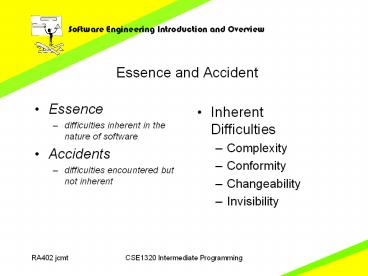Essence and Accident - PowerPoint PPT Presentation
1 / 19
Title:
Essence and Accident
Description:
difficulties inherent in the nature of software. Accidents ... Software Engineering Metrics and Models, Conte, S.D., H.E. Dunsmore, V.Y. Shen; ... – PowerPoint PPT presentation
Number of Views:37
Avg rating:3.0/5.0
Title: Essence and Accident
1
Essence and Accident
- Essence
- difficulties inherent in the nature of software
- Accidents
- difficulties encountered but not inherent
- Inherent Difficulties
- Complexity
- Conformity
- Changeability
- Invisibility
2
Software Engineering Processes attempt to
maximize QUALITY in the form of
- Testability
- Understandability
- Modifiability
- Reliability
- Portability
- Efficiency
- Human Engineering
3
Software Engineering Processes
- Why?
- Issues concerning software quality
- Relative costs of fixing faults
- Price performance factors
- Product size increase leads to larger teams
4
What are the phases in the lifecycle of a
software product?
- Requirements
- Specifications
- Design
- Implementation
- Integration
- Maintenance
- Retirement
5
Requirements Phase What I need, not what I said
I needed
- What does the problem require in terms of the
solution? - Written document
- Customer driven
- Requirements testing
- Rapid prototype
- Mock-up
- Partial system
6
Specifications PhaseWhat the developer wants to
know
- What does the product do?
- What are the constraints on the product?
- Acceptance criteria
- Frequent problems with a spec
- ambiguous
- incomplete
- contradictory
- Specifications testing
- SQA
- reviews
7
Design PhaseHow does the product do what it is
supposed to do?
- Analysis of the problem
- Structured analysis decomposing problem by how
data is manipulated (acted upon) - Object-oriented analysis decomposing problem by
how data is represented
- Developer must make design decisions about
- algorithms
- data representations
- I/O interfaces
- data flow
- modules
- Design testing
- traceability
8
Implementation PhaseInitial CS courses have to
focus on this element first
- Code
- Documentation
- Tests
- Implementation testing
- desk checking
- test cases
- reviews
9
Integration PhasePutting it all together
- Composition order
- Integration testing
- interfaces
- Testing
- does it meet the specs?
- product testing by SQA
- acceptance testing by customer
10
Maintenance PhaseIn the users hands
- Why?
- operation
- documentation
- turnover
- Kinds of maintenance
- Corrective
- Adaptive
- Perfective
- Preventive
- Maintenance testing
- changes
- regression testing
- Retirement
- cost-effective?
11
Specification principles
- Separate functionality from implementation
- A process-oriented systems spec language is
required - A spec must encompass the system of which the SW
is a component - A spec must encompass the environment in which
the system operates - A system spec must be a cognitive model
- A spec must be operational
- The spec must be tolerant of incompleteness and
augmentable - A spec must be localized and loosely coupled
12
Analysis principles and issues
- What differentiates one analysis technique from
another? - hueristics and notions
- point of view
- notation
- modeling approach
- What things are common about analysis methods?
- hierarchical representation
- external and internal interfaces
- design and implementation foundation
- no focus on constraints or validation
13
Analysis principles and issues
- Analysis is information-driven
- First provide a mechanism for representing info
then derive function and behavior - Common characteristics
- mechanism for info domain analysis
- approach for functional and/or behavior
representation - definition of interfaces
- mechanisms for problem partitioning
- support of abstraction
- representation of essential and implementation
views
14
TestingTesting cannot show the absence of
defects, it can only show that software defects
are present.
- Testing is a process of executing a program with
the intent of finding an error. - A good test case is one that has a high
probability of finding an as yet undiscovered
error. - A successful test is one that uncovers an as yet
undiscovered error.
15
Testing Methods
- Black-box testing
- Knowing the specified function that a product has
been designed to perform, tests can be conducted
that demonstrate each function is fully
operational. - White-box or glass-box testing
- Knowing the internal workings of a product, tests
can be conducted to ensure that "all the gears
mesh". - independent paths at least once
- logical decisions both true and false
- loops
- internal data structures
16
Development Testing
- Debugging approaches
- brute force
- backtracking
- cause elimination
- Before you fix
- Is the cause of this bug also reproduced
elsewhere? - What new bug might I be putting in?
- What would have prevented this bug?
17
Software Configuration ManagementChange is
inevitable
- Activities of SCM
- ID change
- control change
- ensure that change is properly implemented
- report change to others
- SCM output
- programs
- documentation
- data structures
SCM is not the same as maintenance
18
Systems Engineering Issues
- Takes customer-defined goals and constraints and
derives a representation of function,
performance, interfaces, design constraints and
information structure that can be allocated to
each of the generic system elements available.
19
Software Engineering Notes for CSE1320
Intermediate Programming
- Sources
- The Mythical Man-Month, Brooks, Frederick P.
Addison-Wesley Publishing Company, (Reprint)1982 - No Silver Bullet Essence and Accidents of
Software Engineering,, Computer, Vol. 20, No. 4
(April 1987) pp. 10-19 - Software Engineering,Schach, Stephen R.Aksen
Associates Incorporated Publishers, 1990 - Software Engineering, A Practitioners
Approach,Pressman, Roger S.McGraw-Hill, Inc.
1992 - Software Engineering, Design, Reliability,and
Management,Shooman, Martin L.McGraw-Hill, Inc.
1983 - Software Engineering Metrics and Models, Conte,
S.D., H.E. Dunsmore, V.Y. ShenThe
Benjamin/Cummings Publishing Company, Inc., 1986































